Introduction
The Indigenous Taiwanese Peoples are the first inhabitants of Taiwan in recorded history. Inextricably tied to Austronesian peoples, their surviving culture is of great importance to the world. Due to geographical barriers in Taiwan and the thousands of years of relative isolation, various distinct cultures inhabit Taiwan, all speaking different languages, with at least 26 groups being known to have existed. As a result of Dutch, Chinese, and later, Japanese occupation, the Indigenous Taiwanese suffered population and cultural loss, and in some instances, even genocide. Some, such as many of the lowland tribes, have been largely assimilated with the Chinese, while others, such as the Saisiyat, fled to the mountains or other less populated regions. As of today, there are 16 tribes recognized by the Taiwanese, and many others that aren’t. With the help of academic study, ethno-tourism, and programs aimed at preserving indigenous culture, there has been a cultural revival among the highland and lowland tribes.
Overview of Traditional Territories and History of Taiwanese Indigenous Peoples
The Indigenous Taiwanese can be rough divided by geographic regions, cultural and linguistic relation. The three main tribes in the northern mountainous region of Taiwan, the Atayal, Seediq, and Truku, share a linguistic and cultural heritage, with the Seediq having split off from the Atayal hundreds of years ago, and the Truku having split from the Seediq. Combined, the three tribes occupy the mountains of Northern Taiwan, encompassing Taipei, Taoyuan, Miaoli, Hsinchu, Yilan, and the northern of stretches of Hualien, Nantou, and Taichung. The Saisiyat, having been pushed into the northern mountains, reside in close proximity to the Atayal in Miaoli, therefore, cultural exchange has taken place over the years.
In the central and lower part of the Central mountains in Taiwan reside the Tsou, Thao, and Bunun. The Tsou inhabit a region across Nantou, Chiayi, and Kaohsiung, and share cultural and linguistic ties with the Kanakanavu and Saaroa tribes further south. The Thao reside near the Sun Moon lake, in close proximity to both the Seediq and Bunun. The Bunun are spread across the mountains of Nantou, Kaohsiung, Hualien, and Taitung.
Near the Southern coast are the Amis, Kavalan, Sakizaya, Puyuma, and Paiwan. Amis territory stretches across the plains and coasts of Hualien and Taitung. They share the northern part of the coastline with the Kavalan, who were originally from Yilan, and the Sakizaya, the original inhabitants of Northern Hualien. The Puyuma, once dominating the area that is now Taitung city, are now sandwiched between the Amis and the Rukai and Paiwan. The Rukai and Paiwan reside in the Pingtung peninsula, with the Rukai in the mountainous interior, and the Paiwan near the coast. These groupings, while important cultural indicators, had a less pronounced social effect, as individual tribal units would have thought of themselves as independent entities or part of larger clans, and only very rarely did some larger coalitions form to combat other coalitions or invaders.

The Western Plains of Taiwan were once inhabited by various lowland tribes, with the Pazeh, Papora, Babuza, and Taokas in the Central plains, and the Siraya, Taivoan, and Makatao in the Southern plains. All of these tribes were severely impacted by Dutch VOC and later Chinese colonists. The Kingdom of Middag, a powerful confederation in the mid-Western plains, resisted the Dutch and Chinese into the early 1800. While many people assimilated into the Chinese population, a few remaining tribes migrated to Puli, Nantou, where most of their descendants are today. Most of these Tribes have yet to be recognized by the Taiwanese government, and many of their languages are either extinct or moribund, but linguistic research have managed to revive and revitalize a few.
Near the Southern coast are the Amis, Kavalan, and Sakizaya. Amis territory stretches across the plains and coasts of Hualien and Taitung. They share the northern part of the coastline with the Kavalan, who were originally from Yilan, and the Sakizaya, the original inhabitants of Northern Hualien. This group, thought to determined to have been culturally and linguistically related by experts also included the now extinct Basay/Ketagalan peoples who lived in the region now known as Taipei. According to Spanish Chroniclers who occupied parts of Northern Taiwan during the 1600’s, the Basay/Ketagalan were well known for their multilingual capabilities, affinity for trade and maritime activities, and offering their services as craftsmen and smiths to other peoples of the Western Coast. According to Sakizaya oral history, the Kavalan also occupied a similar role on the East Coast, as well as the Amis to a certain extent.
The Puyuma, once dominating the area that is now Taitung city, are now sandwiched between the Amis and the Rukai and Paiwan. The Rukai and Paiwan reside in the Pingtung peninsula, with the Rukai in the mountainous interior, and the Paiwan near the coast. These cultures share a common social structure, with strict castes of nobles and commoners. It was not uncommon for castes within a community to have different ethnic identities.
These larger ethnolinguistic groupings do not reflected political divisions, as individual tribal communities would have thought of themselves as independent entities or part of larger clans, and only very rarely did some larger coalitions form to combat other coalitions or invaders.
Early on, the seafaring capabilities of Taiwan, while leaving few pieces of Archaeological evidence, were noted by historical observers. Records from the Song Dynasty about 1000 years ago recall raids on the Fujianese coast by “barbarians”(likely the ancestors of the Basay/Ketagalan) by bamboo raft(Needham). Multiple records throughout Chinese and Japanese history also show that warlords and emperors had made an effort to visit, colonize, and trade with the Taiwanese to varying degrees of success. It is likely, from archaeological and historical evidence, that the Indigenous Taiwanese were used to frequent overseas contact and trade with the Chinese, Filipinos, and Europeans, with trade with the Philippines and the rest of Southeast Asia dating to at leas 1000BC.
Warrior Cultures
The tribes of Taiwan are warrior cultures in the purest sense, as every man in the community is expected to, at some point, to be a warrior and a hunter. The Indigenous Taiwanese are well known for being headhunters, and before being subjugated by the Japanese, endemic tribal warfare and warfare on a larger scale was carried out regularly. Weapons used by the tribes included spears, bows, stone clubs, and knives/ war swords, and later, muskets and rifles, which were introduced by the Dutch, Chinese, and later Japanese.
Some highland tribes, such as the Atayal, Seediq, Truku, Bunun, and Paiwan, were perceived as more bellicose, and thus created friction with foreigners. By the end of the 20th century, the Indigenous Taiwanese had already clashed with the Dutch VOC, Ming and Qing Dynasty China, Japanese(with the Wushe uprising being the most famous and shown in the film Seediq Bale: Warriors of the Rainbow), and even the US navy, during the Rover incident, where a skirmish between Paiwan tribesmen in southern Taiwan and American Marines took place. Indigenous Taiwanese warriors also served with distinction during WWII, in units of “Takasago volunteers”(Takasago Giyiutai), and were considered expert jungle operatives by both Japanese and allied forces. One such volunteer, Teruo Nakamura(Attun Palalin/Suniuo), an Amis tribesman, was the last known Japanese holdout, having survived in the jungles of Morotai with little else other than his rifle, pot, mirror, and knife.





Today, the knife is still an important tool and symbol of many indigenous communities across Taiwan. It is still considered an indispensable tool for going into the bush, with many hunters finishing off their kills with the knife, as the rifles legally allowed by the Taiwanese government lacking the capability to kill larger animals like boar. The knife is also an important component in other aspects of indigenous cultures, such as rattan & bamboo harvesting, as part of traditional dress, and in ritual & festivals.
Before the Knife
There has been human habitation in Taiwan throughout prehistory for at least 20,000 years; however, the archaeology suggests that an Austronesian speaking culture possibly from what is now Southern China, near Fujian, was brought and spread throughout Taiwan around 5,000-6,000 years ago. Named the Dapengkeng culture, they were likely millet farmers with advanced stone tools and pottery. Stone adzes, Patu stone clubs, and pottery shards left behind are indicators of their presence, and bark beaters, for making barkcloth have also been found, a possible origin for bark cloth and tapa manufacturing techniques found in Taiwan and throughout Austronesia. The peoples of Taiwan remained a neolithic culture at least until 4,000 years ago, for the peoples who left for the Philippines and the Lapita culture that likely derived from them remained neolithic cultures.
The stone age predecessor to the knife in Taiwan were stone clubs. These clubs likely occupied a similar role in culture and domestic life as knives did when they were introduced. Because of its outward resemblance to the Maori weapon, these clubs are called Patu by archaeologists. These oblong clubs had highly polished flattened surfaces and made mostly out of sandstone. These clubs are found throughout the island, and likely spread throughout Austronesia by the Lapita culture.



Neolithic South East Asia highly prized nephrite(aka jade), which was traded widely throughout the region. Fengtian Jade, a type of jade mined from the Fengtian site in Hualien, Taiwan, is widespread throughout Neolithic sites of Southeast Asia, particularly the Philippines and Southern Vietnam. At the site itself, presence of tools used to mine and process jade seems to indicate that there was an industry around jade in the Eastern Coast of Taiwan, and jade was a chief export with other regions of Taiwan, and the Philippines, where it was traded to the rest of Southeast Asia. The uniformity of certain types of jade product throughout the region has led many experts to postulate the existence of a mechanism for which skills were transferred, possibly in the form of itinerant craftsmen or resettlement of skilled workers.This trade network laid the groundwork for the transference of other technologies further down the road.
Metallurgy in Taiwan
The earliest signs of Metallurgy were found in South Eastern Taiwan at the Jiuxianglan, Beinan, and Guishan sites(all cultures that bear some resemblance to the later Paiwan and Puyuma cultures), where evidence for Glass, Copper, and iron working have been discovered, dating to about 500BC, roughly coinciding with the Iron Age of the Philippines, where iron producing technology had been introduced by the Sa Huynh culture of Vietnam. This is reflected by a convergence of fashion and jewelry styles, and the sudden appearance of copper in Taiwan, which is an exceedingly rare natural resource on the island. Over the next few centuries, iron working spread throughout Taiwan, and some cultures, like the Basay/Ketagalan served as itinerant smiths for other communities. It is possible in later periods, with the arrival of Chinese settlers that their services as smiths were sought out by indigenous peoples, and exchange of materials, styles, and techniques occurred.
The Formosan Knife
By the time the Indigenous Taiwanese entered history, each tribe had their signature style of knife. However, all knife styles shared a set of commonalities. Most blades are un-fullered and all were chisel ground to facilitate their use as machetes. In all cultures, there are 2 handle variations: either a socketed handle construction, which allows them to be hafted, or a tapered tang which is hammered/burned into a piece of wood serving as the handle. All tribes in Taiwan had some form of wooden scabbard with an open face on one side. This usually consists of a recess carved into the general profile of the knife on one side, with the knife held by either with wood, rattan wraps, or series of metal wires and plates nailed in place to keep it secure. This was supposedly done to prevent moisture build up that would occur inside an enclosed scabbard. Scabbards of southeastern Taiwan are generally more ornate and carved with culturally significant motifs and patterns.
While no typology exists for the knives of Taiwan, traditional knives can be roughly divided into 2 or 3 groups based on probable spread, geography, and blade profile and other characteristics: The Northwestern Atayalic style lalaw featuring a wide tapering blade. The Tsouic “Poyava” type knives which feature a single edge barons-like profile, and the Southern Paiwanic Tjakit type narrow bladed knives. While examples of knives and swords of the Lowland tribes still exist, they are not numerous enough to determine tribal and geographic affiliation, especially since most have been removed from their historical and cultural context. However, the wide variety of knives attributed to lowland cultures makes it probable that many of the established knife designs found throughout Taiwan may have originated in the Western Plains.
The First Knives
It is difficult to determine exactly what the first kinds of knife appeared in Taiwan were like. Archaeological sources and overseas collections may help confirm the antiquity of several designs. Archaeological sites across the Southwestern plain, dating to the 17th century, yielded several blades of similar profile, however due to the semi-tropical climate of Taiwan, many of these archaeological findings are in poor condition. For these extent examples, the scabbard and other fittings do not survive, but these knives vaguely resemble contemporary iconographic depictions of Sirayan knives used by Sirayan tribesmen by artists of the early Qing dynasty.





A particular knife kept in the Royal Danish Kunstkammer collection also shows some resemblance to the archaeological examples found in Southwestern Taiwan. The knife was recorded to have been in the collection since 1743 but could possibly be several years/decades older, thus more or less contemporaneous with the Qing depictions of Sirayan knives. Having been spirited away to Europe centuries ago, this knife is possibly the oldest intact Formosan knife, spared from environmental degradation and recycling, but as a result of this particular knife’s age and lack of records before its acquisition, it is difficult, if not impossible to determine exactly when and where this knife was made.
The knife is 44cm in length, and the scabbard showed standard characteristics such as the wires used to secure the knife, and also features a variation of the upturned end that is nearly ubiquitous in all the scabbards used by the Indigenous Taiwanese. The handle is the only one of its kind known, as most handles of Formosan blades narrow towards the blade, whereas this particular example is waisted. The blade profile resembles neither Southern nor Northern styles of blade, but rather has features of both. It has a single bevel cross section, like Northern blades, but the junction between the handle and blade resembles that of Southern Paiwanic blades. The blade profile resembles a fusion of the 2 styles, with a gradual taper which suddenly curves at the last section into a tip, but remains narrow at the base. It is possible that this particular knife represents an early type of knife from which the other styles developed from, but it could also represent a regional style no longer in existence.
Lowland “Pingpu” Knife Designs
It is difficult to classify and appreciate the variety knives used by the various lowland Pingpu knives, given their own disparate origins and long histories. Many, like the knives of the Pazeh and other North-central Tribes of the western plain resemble Atayal, Seediq, and Saisaiyat knives. This might be a result of possible shared heritage between the groups or frequent trade. South Western tribes often had interactions with the Rukai and Paiwan, and possibly shared in their knife design, however, this has been difficult to establish due to the small number of examples positively identified with the Southwestern lowland tribes. This wide variety of designs might reflect either a source from which other designs branched out, or a accumulation of designs from various regions, within and outside of Taiwan.





A common form of knife positively identified with lowland cultures is a short, straight-backed variety similar to some smaller, lalaw style northern knives. The design also happens to resemble fighting knives used by the Han Chinese that emigrated and eventually assimilated the Lowland tribes. The sheaths often displays artistic motifs often resemble Chinese art, possibly indicating that the production of these knives were possibly influenced by Chinese craftsmen.






Another variation of Pingpu lowland knife a semicircular bellied blade attributed to Sirayan peoples, as archaeological examples have been found. While similarity with Tsouic knives might be coincidental, as there’s limited evidence of transmission between cultures, its possible that this form of knife might have represented a type of knife that was once more widespread across Taiwan.



The Tsou Pojava
The Tsou Pojava/Poyave(pronounced Po-Yava), represents a class of knives that are used by peoples living along the Central Mountain range of Taiwan. The profile of the knife resembles an elongated semicircle and distinct from other Formosan knives.

The Tsou, living in the region surrounding Alishan national park, use these knives called poyave no sungcu, meaning straight knife, accompanied by with a Kacace, an ornate belt beaded with cowrie shells and other decorative materials. The sheaths of these knives are often painted red as red was believed to be the favored color of their war god, and a wooden strip was also often attached to the back of the sheath. Unlike many sheaths of other peoples in Taiwan, in addition to wire, Tsou sheaths would also have long, flat places of metal varying in width. In the past, villages had forges which, according to Japanese records, were set up in part, by Han smiths from the lowlands. The suspension system for the knives were different in the north and south, as in the north the Poyave would’ve been tied to the waist by sword belt and shoulder strap whereas in the south, the swordbelt would be the only means of suspension.

The Thao people living nearby the Sun Moon lake also have knives with a similar profile to the Poyave. In Thao society, the Skapamumu clan was in control of all metal work, which were traded for by other clans for other goods. Fittings were similar to the Tsou, where a belt and a shoulder strap were used. The Kanakanavu people further south also used similar knives. The Bunun, who occupy territory that envelopes the Tsou, Thao, and Kanakanavu use a large variety of knife designs, but also use knives similar to the Poyave.
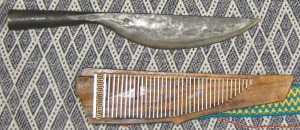
The Atayal also used knives similar to the Pojava called the Lalaw Topuw, which resembles a Barong in it’s semicircular blade profile, except for the fact that the back of the blade is completely straight, and features no false edge. The Atayal lalaw topuw was used more as a tool, were mostly socketed(I have yet to find one that isn’t), and usually under a foot long. When hafted(a common practice), it could be referred to as a Qopo.



As stated in the segment above, archaeological examples of knives attributed to the Siraya also resemble the Pojava and Lalaw Topuw, and were mostly smaller examples under a foot long. The disparate nature of the distribution of these knives could possibly indicate a once larger range and greater popularity throughout Taiwan that has since been reduced to what we can see now.
Northern Knife Designs
The knives of the indigenous peoples of Northern Taiwan encompassing the Atayal, Seediq, Truku, Amis, Bunun, Saisiyat, and various plains tribes share general features and methods of construction. Although the features of the knives are very consistent between the different peoples using them, these cultures are not necessarily directly related to each other, with some being part of same macro group while others coming into contact via migrations.

These Northern knives have a variety of blade profiles, but share a few commonalities. The blades are generally flat or convex ground, sometimes featuring a one sided chisel grind. A universal feature of these knives is the considerable width of the blade at the base and a relatively narrow tang, thus the tang is situated near the center of the blade, so while there is no guard, the blade extends past the fingers essentially forming a choil/heel on either side of the handle. The entire blade is usually canted forward, though the degree varies greatly between knives.
The Atayalic peoples, Atayal, Seediq, and Truku, use knives that display a range of variation depending on geographic, functional, and cultural influences. According to the Shung Ye Museum of Formosan Aborigines, Atayal knife profiles are straight in the North and become more curved further south. However, this statement is likely an overgeneralization and challenged by the multiple examples of curved blades in the collection of the Wulai Atayal Museum(at the Northern most tip of Atayal territory), photographic, oral, and archaeological evidence. Oral sources have also suggested that straight backed knives came into popularity after the arrival of Japanese as they were influenced by bayonet designs. these straight knives sometimes featured a canted handle and usually had a consistent distal taper from the base of the blade to the tip, where it often tapers more dramatically. The Saisiyat Malat knife more or less resembles a variation of straight-bladed lalaw, with the Saisiyat possibly having shared the design after coming into contact with the Atayal, or having inherited the design from the indigenous cultures of the northwestern plain distantly related to both the Atayal and Saisiyat.
Curved Atayal knives are indistinguishable from Seediq knives. The knives are usually canted forward and feature a consistent curve and distal taper, thus making the knife a good chopping and cutting tool. The knife curves back so that the point is closer inline with the handle, which makes the knife useful for thrusting as well. These knives were usually 2-3 feet long, but large knives intended for headhunting and warfare can reach gigantic proportions up to 4 feet. Truku knives share most features of Atayal and Seediq knives, but their utility knives tend to remain mostly straight and only curving and tapering at about ½ to ⅔ of the length.
The variety of knives used by the Atayal, Seediq, and Truku have specific names which reflect their function and usage. The general term, Lalaw or Lalaw behuw(Pucing is another term used by some Atayal groups and the Truku), were often used for hunting knives with about 2-3 feet in length. Takis seems to have been another term used for these knives in some Atayal dialects. Smaller lalaw which were used as utility knives, have also been referred to as Muli in Atayal, and sometimes hafted for use as a spear or polearm. The large meter long war swords were sometimes referred to as the Mgaga in Atayal, and Slmadac in Seediq. They held more ceremonial and cultural significance, and were intended for use in ritual warfare and headhunting. They were also less common than the other examples, and more often than not, belonged to the more accomplished and respected individuals of a village.



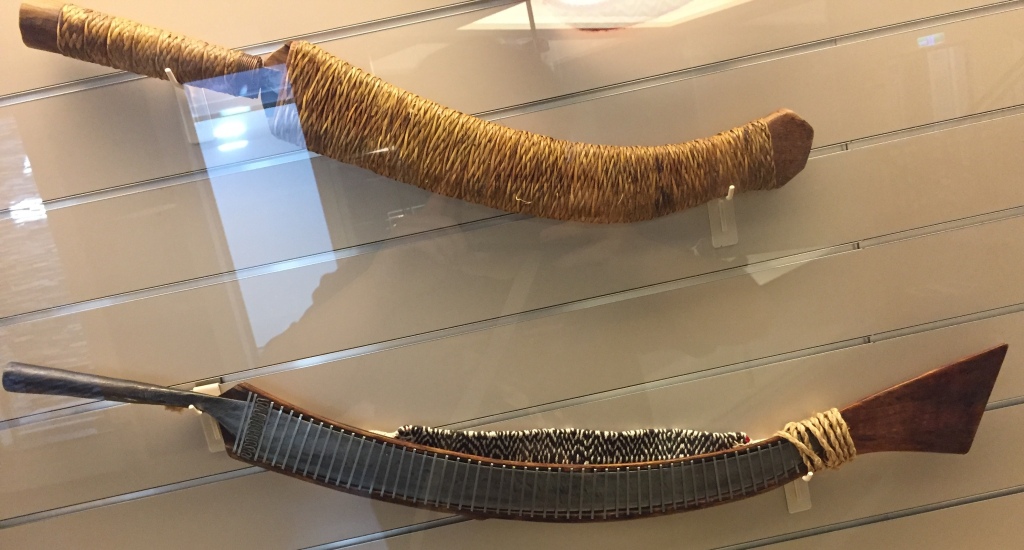

The Atayal, Truku, and Seediq have many explanations for variations in blade lengths. While one might imagine blade lengths of knives used in deeper, wooded areas might be shorter and thus less prone to be caught in the bush, this is generally not the case. An explanation, while often framed as a joke, states that longer blades were more effective against the sessile Han Chinese peoples, who generally dug in for a fight, while shorter blades were more effective in skirmishing against tribal enemies, as shorter blades and lightning fast reactions could mean life or death. This, while thrown around by tribesmen as a joke, might explain the geographic distribution of blade lengths, as the Truku, despite living near the open plains of Hualien, often in contact with neighboring Seediq, Amis, and Bunun, often used short blades, while the Atayal and Seediq in mountainous and densely forested areas generally used longer blades, possibly due to contact with the Chinese, who sometimes ventured into tribal territories for timber.
Northern Bunun Sinhailee knives resemble Atayalic knives in most respects, with their smaller knives resembling the Truku Pucing and larger knives resembling the Slmadac/Mgaga war swords. Amis peoples in contact with the Truku, Seediq, and Bunun often adopted blades similar to the curved lalaw.
Northern Scabbards and Fittings
In most Northern knives, the scabbard consists of a plank of wood with a recess carved into one side, with wires stapled across the opening to keep the knife in place, but usually, the friction fit alone is enough to keep the knife in place. An explanation often given is that these open sided scabbards prevented the trapping of moisture around the knife. Traditionally, these scabbards are either trapezoidal in shape for straight backed knives, or for curved knives, follow the shape of the blade and feature a “stock”at the end of the handle, often held when unsheathing the knife. This stock is often the main varying feature between different designs. Many have tried to make the case that these variations in scabbard design could be used to differentiate the knives used by different peoples; however, given that we often see the same variations in the scabbards used by each tribe, it is likely not a reliable indicator. These stocks either resemble a rough diamond pattern, with protrusions on both sides or a “gunstock/fishtail”, with a protrusion only on the bottom side. Back in the old days, long tassels of human hair from victims of head hunting would have been used to decorate the stock. The “throat” of the scabbard is carved into the shape of the “finger guard”, although over hanging a bit. This serves as a sort of platform for the thumb to push off of as the knife is unsheathed. According to some tribesmen, the wood of scabbard can be used as kindling for fire, and may have been made of easily flammable wood for this purpose.

Two styles of handle construction seem to be prominent among these knives, with neither dominating in any one region. One style is the simple socketed handle, present on knives throughout Taiwan of all lengths and designs. Generally, the top end of the socket is left open. One explanation was to prevent moisture buildup within the socket. Smaller blades of socketed construction were often hafted for use as spears, javelins, and polearms, and were also used in the unique practice of mounting a “bayonet” on longbows when closing the distance with animals or enemies. The wooden handle, while not allowing for such versatile use, is nonetheless widespread. The tang of the knife was shaped into a spike, then burned or rammed into a conical piece of wood, and held by friction. While the tang wasn’t usually long enough to fully pass through the handle, when it did, it wasn’t penned, but often just bent over, much like a Chinese meat cleaver. The wooden handle, to prevent splitting, was reinforced with wire or organic material wrapped/ woven around as a grip. Sometimes, a metal ferrule is fitted at the junction between blade and handle, however, this feature is mostly seen on knives made today and rarer in the past. The blade was rarely pinned to the handle or glued, although there is a method attested by some, where the tang was deliberately rusted in the handle for a better friction fit. Both types of handles were slightly oval in cross section to facilitate edge alignment.
These swords are usually just tied around the “true waist”, and could thus be removed whenever necessary. The knot was usually some sort of bowline knot that was easy to unfasten. A woven portion was often incorporated into the belt. This practice is slightly different from Southern Tribes.

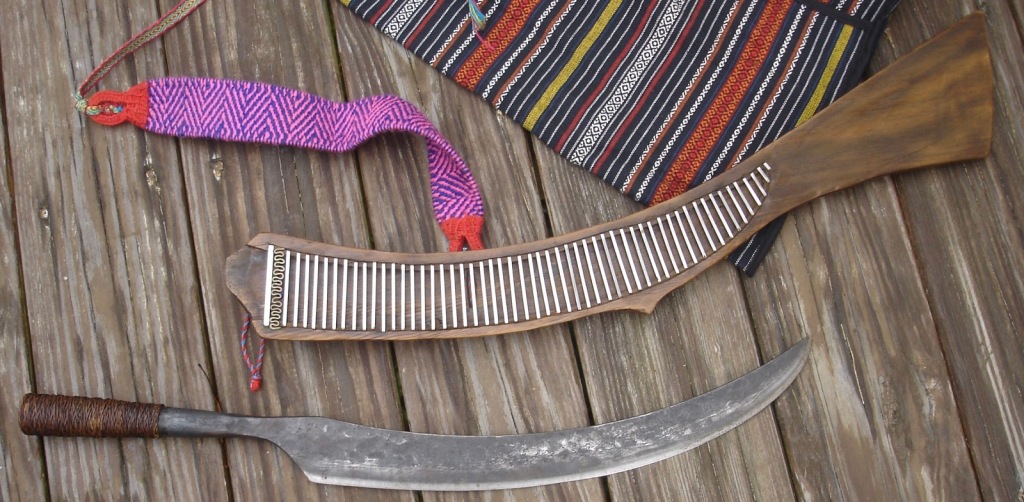



Southern Knives
Another grouping that can be considered are the blades of the Puyuma, Paiwan, and Rukai, referred to as the Tjakit in the Paiwan language, the TaDaw in Puyuma/Pinuyumayan, and Lab/Lrabu/Rinadrug in Rukai.
The “Proto Tjakit“
While some early examples attributed to the Siraya bears a vague resemblance to Southern knives, there is another archaeological example that is closer to home. A knife in the collections of the National Museum of Prehistory in Taitung features a lot of characteristics found in later knives of Southeastern Taiwan. This particular example can likely be attributed to the descendants of the Beinan culture i near the Taitung plain, and shares some features of southern knives. It bears a cylindrical handle with a totemic depiction of a man at the pommel area, resembling later Puyuma blades, and a narrow blade profile similar to the later knives of the region. While this particular example is rather short, it is likely that it resembles the ancestral form of the knives of this region.

National Museum of Prehistory
Paiwan, Rukai, and Puyuma Warrior Cultures
Historically, the Paiwan, Rukai, and Puyuma had strong warrior cultures and forged powerful multiethnic tribal confederations/kingdoms which dominated much of the Pingtung peninsula. Each man was expected to undergo communal warrior training not unlike popular conception of the Spartan Agoge. The Puyuma have an institution for training young men known as the Palukkuwan which still exists to this day.
.

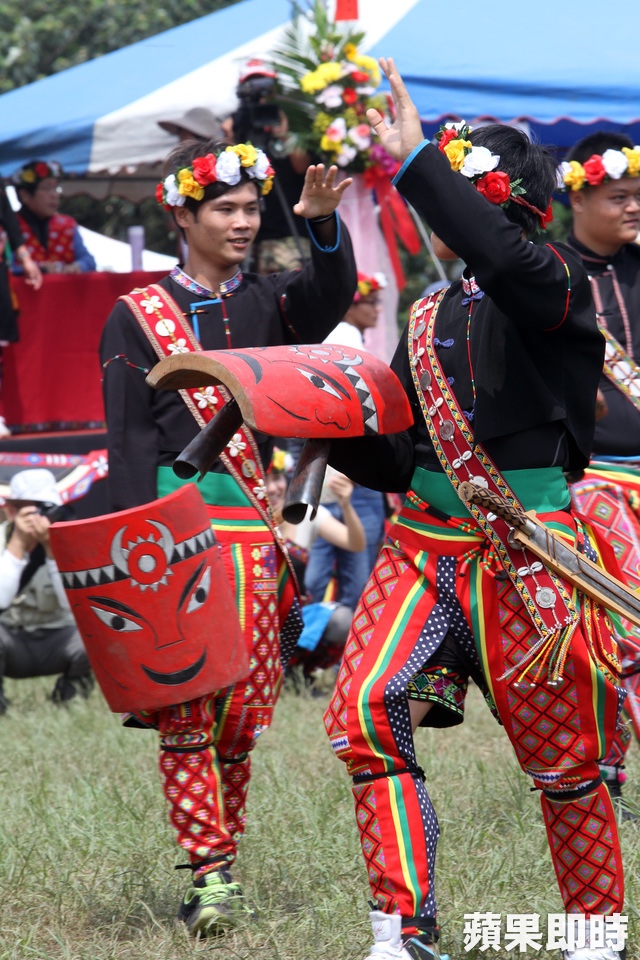




Warriors of the Paiwan, Rukai, and Puyuma were traditionally armed with spears, shields, swords, and occasionally bows, and later guns, with the primary weapons being the spear and the shield. The Southern Taiwanese shield is usually horizontally center gripped, rectangular, and made of 1 or 2 planks of wood. Many shields made of 2 planks often have a slight V cross section, with the junction between the 2 pieces secured by natural cordage woven through predrilled holes. The handle is similarly woven on. Theses shields varied in size, ranging from body sized to 1-2 feet in height, with a gradual shrinking in size as firearms became more prevalent. While these shields lost much of their battlefield use as time moved on, they were retained as ritual and cultural objects. However, it is important to keep in mind the role of the shield in the past when it comes to the swords of Southern Taiwan.
Knives of the Rukai, Paiwan, and Puyuma
These blades, like their cousins in the north, have an asymmetrical, chisel ground cross section, but are unique for featuring a well defined secondary bevel on one side of the blade, with the bevel closer to the spine for the Paiwan Tjakit and near the edge for Rukai Lrabu. In some Paiwan blades, a few are hollow ground on the flat side. These straight-single edged blades feature little to no distal taper, and thus the edges are nearly parallel until the tip, where the knife has an angled transition to the tip, similar to the kissaki on Japanese blades or the tip on Chinese blades. There is an interesting change in these Southern blades in that in earlier blades, the tip resembled Chinese blades, where the grind line meets the tip, providing a reinforced point, and the angle of the tip is usually around 45 degrees, whereas more modern blades feature a tip much like the Japanese kissaki, and are gently curved. It is possible that this change began with Japanese contact and later occupation of Taiwan, which the Paiwan were severely impacted by.







The Paiwan had 2 different types of knife, a utility knife/machete called the “sisavavuavua tjakit” and the ceremonial war sword known as the “sitjeqalaqala tjakit”. The utility Tjakit is usually less ornately decorated, and either features a socketed handle, or simple wooden handle. The Ceremonial war Tjakit exclusively has ornately decorated wooden handles.
Scholars Philip Tom and Sherrod V. Anderson have also been able to determine that these knives were constructed using qianggang/Sanmai construction, where softer, carbon poor steel is sandwiched around a carbon rich steel which also forms the edge, and heat treated with “considerable skill”. This has led them to posit a relationship with Chinese Blades from the Song Dynasty and earlier. Other possible influences on Southern Taiwanese blade design include shipwrecked sailors from Okinawa and Japan and various Filipino cultures that had traded with Taiwan until recently.
The Tjakit-type knife family is dominant in much of Southern Taiwan. While the dominant style of knife for Paiwan, Rukai, and Puyuma cultures, this type of blade was adopted by many neighboring peoples, including the Southern Amis, Bunun, Hla’alua/Saaroa, and the later arriving Taivoan and Makatao, though aspects such as scabbard and handle decoration was less widespread.
Fit and Finish of Southern Knives

Among the Paiwan and Rukai, ornamentation is of utmost importance. Unlike the rest of the tribes of Taiwan, the Southern Tribes had a strictly stratified social structure resembling a caste system, with distinct noble families. Considered one of the 3 treasures of Paiwan culture, along side glass bead making and pottery, the Paiwan Tjakit were crafted by the Pulima, an aristocratic caste serving as craftsmen for objects of prestige. The Tjakit, along side the other 2 treasures, were often given as high status gifts during special occasions like weddings, either as a dowry or bride price, or alliance forging. The handles and scabbards of Paiwan, Rukai, and Puyuma knives are ornately carved and painted, something generally absent from many other tribal knives in Taiwan. These decorations became more ornate depending on the social status of the owner.
The scabbards are usually made of Kleinhovia hospita or Taiwanese ebony(Diospyros philippinensis). These usually have a rectangular/trapezoidal design to conform with the shape of the knife, but the end is curved up like the bow of a ship. The protrusions at the end are often small and decorative, though some, in particular, those of the Puyuma, extend for a few inches. Like the scabbards of the north, the scabbards of the south often have wires stapled to the side to keep the blade secure, but unlike those of the north, these wires also serve a decorative role, twisted, coiled, and bent into patterns, with wires running nearly the entire length of the scabbard a common feature. Sometimes, copper/brass/bronze plate or wood panel is glued or stapled on, the surface of which also serves as a canvas for decoration.
Handle construction is similar to Northern knives, although with more emphasis on decoration. Socketed handles are usually decorated with a woven rattan grip. Wooden handle construction varies, as some knives feature a through tang with the tip hammered over the end(common in Chinese cutlery often used by Chinese settlers throughout Taiwan) or a tang that is hammered into a piece of wood and sealed with adhesive. The more prestigious wooden handles are often fitted with a ferrule, and have a cylindrical, rectangular, or flattened octagonal cross section, sometimes a combination of the above. Each surface was carved, painted, and inlaid with precious metals, stones, mother of pearl, and other decorative elements. It is not uncommon to find Chinese, Japanese, or even American coins glued or embedded onto the scabbard, sometimes even used as a small disc guard, though the guard was far from a universal feature. The flattened octagonal handle in particular was a common feature of Rukai knives, though since the Japanese occupation, the handle was adopted by neighboring Paiwan villages, and had since become the dominant aesthetic for Southern Taiwanese knives.
The emphasis on decoration is likely linked to the affinity of Rukai and Paiwan tribesmen for wood carving, with the handle and scabbard serving as a surface for displaying craftsmanship. Motifs/totems are hammered in metal and carved into the wood, common ones being faces, often representing ancestors, and the “hundred pace pit viper”(Deinagkistrodon), an animal of significant importance to the Paiwan, Rukai, and Puyuma.

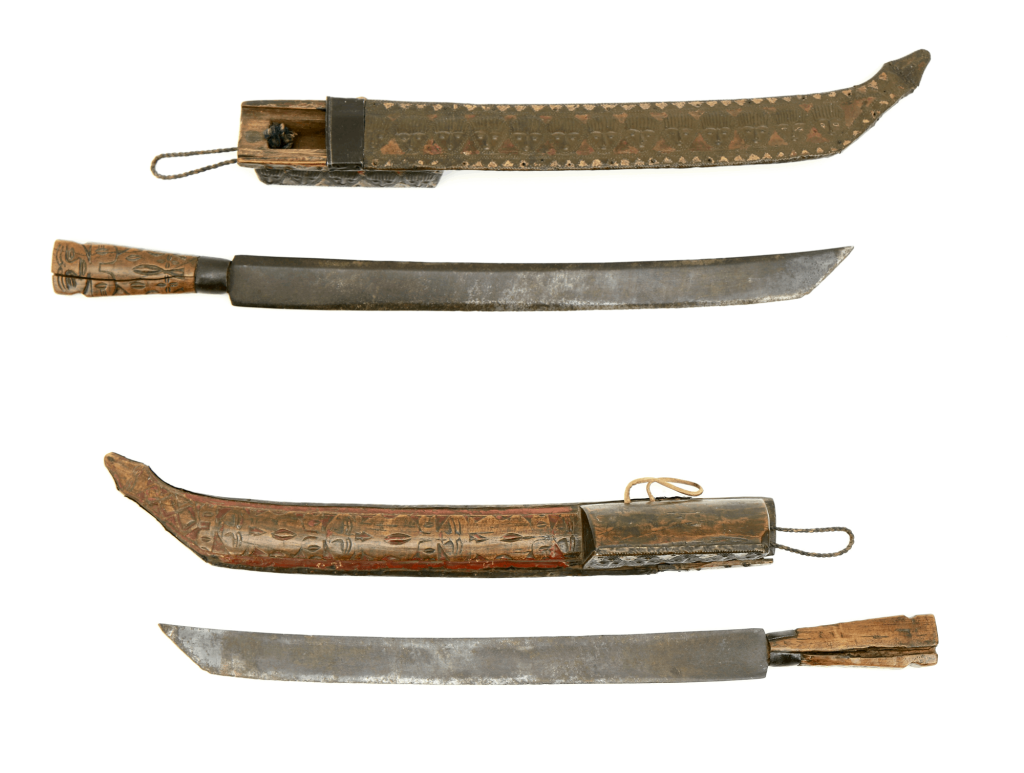



Photo and description Courtesy of Peter Dekker of Mandarin Mansion
On the upper portion of many Paiwan scabbards, there is often a box or protrusion. These are roughly trapezoidal/rectangular, and are hollowed out for storage of materials such as tinder. The knife, when in the scabbard, effectively serves as a “lid” for the box. This either facilitates or dictates the way the Tjakit is worn, in which the side of the box props up the scabbard in such a way that the blade faces up. There are roughly 2 ways of tying the Tjakit to the waist. A series of 4 holes are often found on either the forward and backward walls of the box, or on the face of the scabbard itself when the box is absent. A cord is usually strung through each set of 2 holes and tied, forming 2 loops for a belt, which is then tied around the waist. The more ceremonial way of wearing the Tjakit would be to tie or wrap an ornate braided cord of ramie around the scabbard(usually right behind the box), then used the rest of the cord as a belt. In absent of the box, some knives have a small wooden protrusion resembling a strip, and many scabbards, particularly those of the Rukai and Puyuma, have no such protrusion.
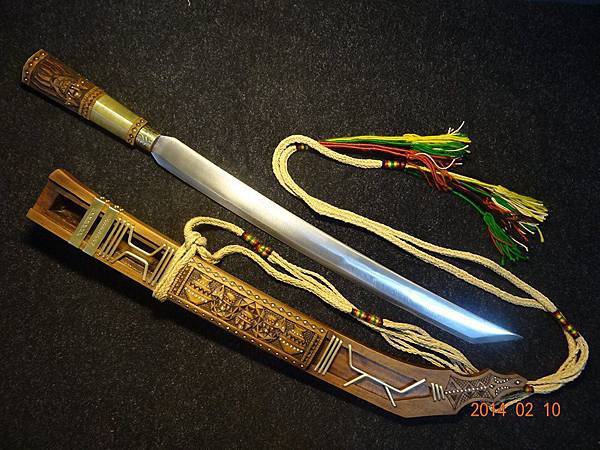



Knives of the Amis/Pangcah
An Introduction to the Amis/Pangcah
The Amis/Pangcah are the indigenous people who occupy much of the Eastern plains. Various colonial powers have tried to categorize much of the people on the Eastern Plain as Amis, and in the past, separate peoples like the Kavalan and Sakizaya have been lumped in as well, however this has since been changed.
Although they are often considered one group, there are various distinct regional organizations. The Pangcah are often separated into several groups:

- Nataroan/Nanshi南勢(Orange on map): the Northern division near Hualien city, including settlements such as Cikasuan village
- Siwkolan/Xiugulan秀姑巒(Red on map): occupying much of the Southern half of the Hualien plain
- Tavalong-Vataan/Coastal(Blue on Map): occupying the southern half of Hualien coast, including villages like C’epo
- Farangaw-Maran/Taitung台東(Green on map): occupying most of the Taitung coast, including settlements such as Fa’rangao & Atolan
- Palidaw/Hengchun恆春(Beige on map): communities of Pangcah spread throughout the inner Taitung plain(Luye and Cishang townships) and Hengchun region in Pingtung county
- The Metropolitan Amis: various communities of Amis based in major metropolitan areas around Taiwan
It’s believed that the Amis near the Northern Hualien plain possibly moved in after the Sakizaya and Kavalan suffered a crushing defeat at the hands of the Qing dynasty military, driving many Sakizaya and Kavalan peoples to hide and assimilate in the nearby Pangcah villages. As a coastal people, the Pangcah are well known for their fishing and maritime traditions. However, not all communities are based around water as settlements such as Kiwit, Ceroh, and Cikasuan are based inland. However, a feature uniting the disparate groups of Pangcah is the age based social hierarchy, in which various age groups perform certain roles in society. It is believed by many scholars that individuals from the modern day Fa’rangao settlement near Taitung City were the first Austronesians to make the perilous journey to populate Island South East Asia, Micronesia, Polynesia, and beyond, likely via bamboo raft.


Amis/Pangcah Knives

In terms of material culture, the Pangcah absorbed much from their neighboring cultures, such as the Truku, Sakizaya, Kavalan, Pinuyumayan(Puyuma), and Paiwan. As such, knives of the Pangcah, called Funos/Vunos, varied greatly depending on region, and like many other things in Taiwan, there is a North South continuum, with Northern knives resembling Atayalic Laraw and Southern knives resembling the Tjakit.
The Nataroan Amis, and perhaps the Siwkolan Amis, as a result of contact with the Truku, Seediq, and Bunun, used knives which were similar to the lalaw. This is also true for the closely related Sakizaya people, who live in close proximity to the Nataroan Amis. A particularly prevalent style of scabbard unique to the region features a long bent elongated diamond-shaped stock with a raised ridge in the center. In the south, the Farangaw-Maran and Palidaw Amis used knives similar to the neighboring Puyuma.



An interesting feature of many Amis knives is the handle, which is asymmetrical, and unlike most knife handles in Taiwan. This takes many forms, either as a outwards protrusion near the bottom of the handle, or a handle that is entirely curved, much like those of many Bolos and Parangs in Southeast Asia. While this feature is common among normal utility knives of the Amis, it is most commonly present in a type of knife known as a “gift knife”. These knives usually have long, curved, narrow blades with fittings entirely made of ox horn, inlaid with mother of pearl. More often then not, these ox horn scabbards are fully enclosed, unlike the one sided scabbards used throughout Taiwan.
The combination of these features: asymmetrical handles, ox horn fittings, and a fully enclosed sheath, while unique in Taiwan, are widespread through Island Southeast Asia. Given the Amis/Pangcah’s seafaring capabilities, along with other factors such as some degree of intelligibility between Amis and some Filipino languages, it is entirely possible that these features might have been the result of foreign influence, perhaps from the Philippines and beyond.


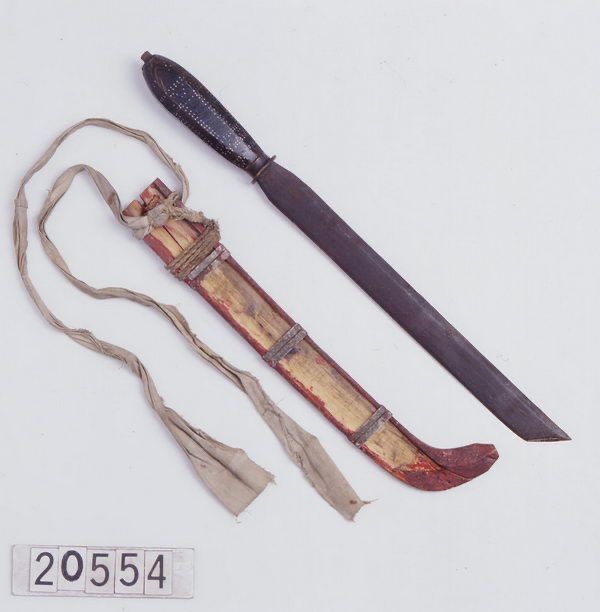

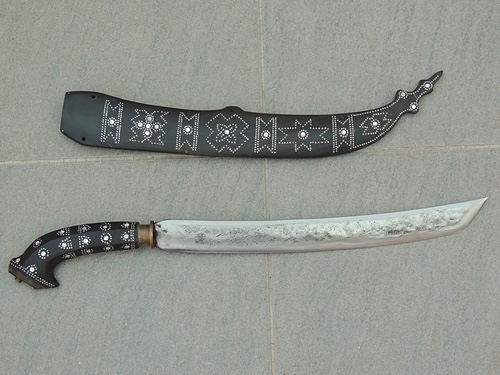

Possible Interactions and Relationships with Knives of Other Cultures
Formosan knives are relatively unique in the world of ethnographic arms and armor. This is not surprising given the relative isolation of Indigenous Taiwanese people. The distinctive and “unifying”(to a degree), features of the Formosan knife are:
- Open faced Scabbard
- Chisel ground cross section
- Wooden and socketed handle variations of each knife
As these features are found in the knives of every indigenous culture in Taiwan, it might suggest a common origin. When we expand our scope a bit further, we can also find styles of knife in the region(Southeast Asia & East Asia) that do share similarities, in particular, the Bolo family of knives of the Philippines and swords used in the Easter region of the Tibetan Plateau.
It would benefit our endeavor of placing Indigenous Taiwanese knife culture in the broader context of Ethnographic Arms by study the rise and spread of iron and steel throughout Southeast Asia. This has proven to be challenging, as conditions of the entire region are particularly poor for iron preservation, thus the easiest way of determining iron use in a region are to find the hallmarks of iron production, such as the presence of foundries and slag. As discussed previously, the earliest archaeological evidence of Iron processing in the Philippines and Taiwan date to around 200BC, with the progenitor being the Sa Huynh culture of Vietnam association with the Cham people and later Champa kingdom. Iron traveled along the long established trade network between the South Vietnam, the Philippines, and Taiwan, which had earlier spread the lingling-o style earrings and exported nephrite from Taiwan to make those earrings. The existence of such a trade route and the transmission of iron working technology makes it plausible that knife designs were also passed along, possibly in the form of itinerant craftsmen, a practice which was widespread throughout the region. Using this framework, we can also explore a possible link to the knives/swords of the Eastern Himalayan Plateau.
Tentative Links
Given that the origins of Indigenous Taiwanese metallurgy can be traced from the Philippines all the way to mainland Southeast Asia, we can expect to find common features of bladed tools throughout this region, possibly from a shared ancestral knife form. The Formosan knife, perhaps because of its relative isolation from other cultures, possibly preserves many of the basal characteristics of Iron Age knives and swords of Southeast Asia. The 3 distinctive features of Formosan knives are possibly some of those characteristics, but are rarely seen together in other knife cultures. However, each of these features can be found in knives throughout Southeast Asia and beyond, as chisel ground blades are common throughout the entire region, socketed handles are commonly found in knives and other bladed tools in Southeast Asia, and open faced scabbards are found in the Eastern Himalayan Plateau and Luzon.
Socketed Handles
Aside from the widespread use of chisel ground blades in Southeast Asia, another common feature of knives in the region is the socketed handle. Much like in Taiwan, a socketed handle is usually just another variant for a handle, the most common other option being a hidden tang. In fact, the method of construction used, burning the tang though a handle reinforced with a ferrule and sometimes a handle wrap, is remarkably similar throughout the region, seen in Cambodia, Vietnam, Malaysia, Luzon, and Taiwan.
In Mainland Southeast Asia, the Dha/Daab/Dav used by the Burmese, Thai, and Khmer bears little resemblance to Formosan knives. This isn’t all that surprising as this particular family of swords is believed by many experts to have originated in the border region between China and Burma, possibly supplanting earlier forms of weapons systems. Despite the popularity of the Dha, many of the utility/“bush” knives and machetes feature socketed handles, such as the Cambodian Kakok and Kambet Bantoh, a double edged sickle shaped axe/machete. They’re are often hafted on a pole/handle of varying length, with the socketed handle allowing for more flexibility. The Thai also use a similar tool, which also commonly has a socketed handle. It is also interesting to note that these knives vaguely resembles the profile of the Kachin Dao, Naga Dao, and Achang Husa of more disparate regions. This possibly represents the survival of a once widespread knife culture that was relegated to the status of bladed tool as other designs were introduced and held to a higher level of prestige.




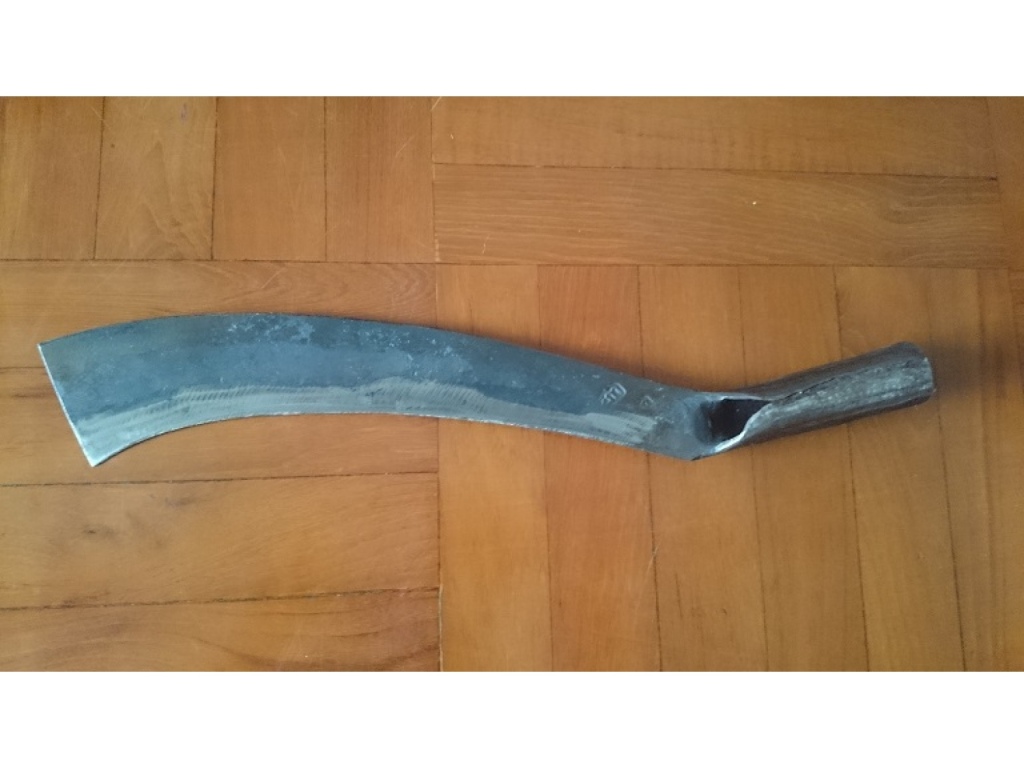

Source: Pinoy Steel
The Eastern Tibeto-Burmese Highlands

The Eastern Himalayan Plateau represents a crossroads of cultures, peoples, and empires, sandwiched between Indian, Tibetan, Chinese, and Burmese-Thai civilizations. It was through this region that Hinduism, Buddhism, Sanskrit, Architecture, Metallurgy, and many other influences traveled from India to Southeast Asia. While the Indo-Chinese peninsula is inhabited by Tai Kadai and Austronesian peoples, a variety of Tibeto-Burmese speaking peoples occupy its North-Western border. Though knife/sword designs in this region vary widely, with some seemingly having taken on influences from Chinese daos and swords, the open sided scabbard seems to be a shared tradition. The Sikkimese Ban, and to some extent, the Tibetan Dpa’dam and Bhutanese Patag swords/knives feature open faced scabbards that are reminiscent of those in Taiwan. In particular, the forms of these blades are somewhat similar to that of the Paiwan Tjakit, as the many Bhutanese Patag swords also happen to have handles with an octoganal cross section, and shares a similar blade profile. However it is likely that the form of these blades have long since changed from any initial design that might have once been popular throughout Southeast Asia.


The Kachin, Naga, Apatani, and Deng people nearby use a variety of knives that not only similar to Taiwanese knives, but also have a tentative link to a much older, widespread design. The most eye catching feature of these knives are the scabbard that strongly resembles those in Taiwan, especially with the evenly spaced strips of rattan that secure the blade in the scabbard. However, the features that are less similar to Taiwanese knives perhaps draw more interesting connections that have broader implications. A connection to the machete/“bush” knives of Thailand and the Cambodian Kambet Bantoh can be drawn as the design is nearly identical to a long-handled variant of the Naga dao.




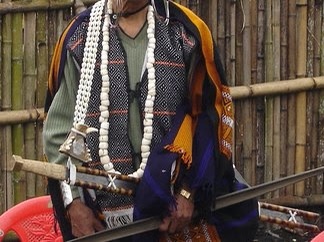


The handle found in the Naga and Deng dao and the broad, fan-like blade profile bears strong resemblance to Iron Age swords found in Java. These swords, with handles that widen at the base and a similar blade profile, are attributed to the Dongson Culture of Vietnam, but also strongly resemble early Iron Age khanda-like Indian swords, possibly pointing to an early khanda-like predecessor to swords of Southeast Asia.
Dayak Knives
The Dayaks of Borneo continued to live traditionally into the modern era. Integral to their culture and way of life are the large varieties of knives, swords and bladed tools unique to their culture. The Parang knife, Pandat, and Mandau swords all belong to the same family of bladed tools, with some like the Mandau and Pandat occupying a higher status as a weapon of war. An interesting example, the Parang Latok, the utility version of the Pandat used by the Bidayuh of Sarawak, can often be seen with an open sided scabbard. The explanation usually given by the Bidayuh is that the open sided scabbard prevents wood chips and dust accumulating in a conventional scabbard. Perhaps what is more telling is the way scabbards are made in the region. Recesses are carved into 2 pieces of wood and sandwiched together to fit the blade. Instead of using any adhesive or nails, woven rattan(Simpai) are used to wrap the 2 sides of the scabbard together. This type of construction easily lends itself to be converted into an open faced scabbard, as all it takes is removing one side of the scabbard and adjusting the simpai wrap.

A video of a Dayak Craftsman making and fitting scabbards with Simpai
On top of occasionally using open sided scabbards, the Dayaks are also used to the concept of socketed handles. They are usually featured on knives that were intended to function both as a knife and a hafted weapon. However, these are seen less often.
Knives of Luzon and the Cordilleras
Knives of the Luzon and in particular, the Cordilleras, perhaps share the most similarities with indigenous Taiwanese designs. The Pinahig and Hinalug knives are used by the Igorot people of the Cordilleran region of Luzon island and share the three characteristic features of Formosan knives: a chisel ground bladed, integral socketed handle, and open sided scabbard. The Igorot also happen to have a variety of cultural similarities with the Indigenous Taiwanese, such as their traditional dress and the practice of tattooing. Personal accounts have also suggested a degree of intelligibility between the Igorot language and the Amis and possibly Paiwan language in Taiwan. As a result of isolation in the Cordilleran highlands, the Igorot and many other peoples of the region are thought to have retained older cultural characteristics not influenced by other cultures and later, the Spanish.



A type of Filippino dagger, perhaps coincidentally, called the Balarao might in fact be a linguistic cognate to the Atayal Laraw in Taiwan. While daggers are rare in Taiwan, they do show up in a few regions. On the island of Botel Togabo, the Yami/Tao people, closely related to the Ivatan people of the Batanes islands north of Luzon have a dagger that resembles the Filipino Balarao. These daggers are usually hung around the neck and sometimes featured fenestrated scabbards. The dagger itself is quite small, but he scabbard is often richly decorated with carvings. Aside from using Tjakit, the Paiwan also had ritual daggers that are unlike any other weapon or tool in Taiwan and closely resembles the Balarao in blade profile and hilt shape, albeit far more ornate. Yami/Tao Knives also happen to closely resemble Formosan Knives, vaguely resembling a Tjakit with an upturned tip. Knives similar to these have been found amongst the Amis and Puyuma. As the Yami/Tao were frequently seen on the Coasts of Formosa trading with the peoples of Southeastern Taiwan, along with close contact between Botel Tobago and Formosa with the Philippines in the distant past, makes it likely that exchange of knife culture very much occurred.
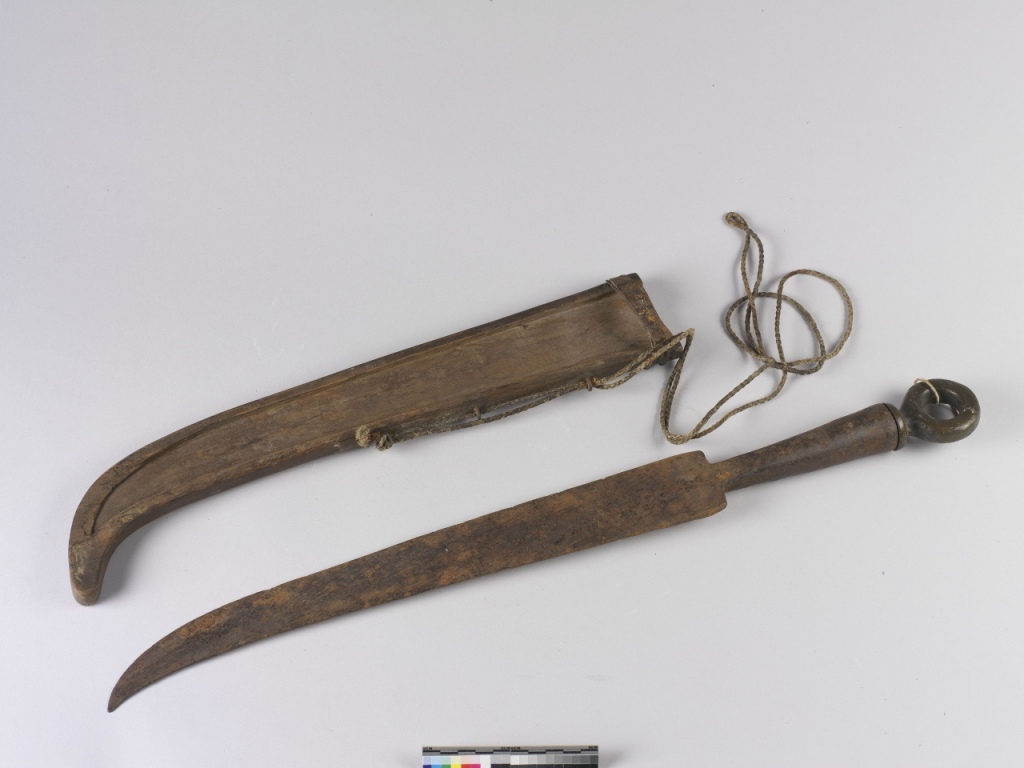





A Tentative Hypothesis
We can perhaps start to piece together a rough picture of how bladed tools and knives spread throughout Southeast Asia with an understanding of how some archaic features managed to be preserved in Taiwan. Broadly speaking, around 200 BC, metallurgy(and by proxy bladed tools) spread quickly throughout island Southeast Asia along well established trade routes previously used for the jade trade. As the conditions for preservation of iron is particularly poor in the region, we must rely on surviving cultures of bladed tools to extrapolate what was being made and spread at the dawn of the Iron Age in Southeast Asia.
From scant archaeological remnants and contemporary artistic depictions, it does seem like in Iron Age Java, a khanda-like sword similar to what was being used in India at the time was popular. This sort of design may have been reflected in the Naga/Kachin Dao, which shares the widening blade profile and handle design. It seems the one sided scabbard was an idea that was also present and spread at the time, shared by far flung regions. As time progressed, some like Sikkimese Ban, Tibetan Dpa’dam, Bhutanese Patag, and possibly Paiwan Tjakit seem to have a kept using one sided scabbards, but adopted more Chinese influenced blade profiles.
In Mainland Southeast Asia, the Dab/Dha type sword seems to have taken over as the dominant type of blade for the prestigious around the Middle Ages, but more archaic features may have been retained in farming implements and bladed tools like the Kambet Bantoh and related machetes/axes. These axes/tools along with other types of blades were spread to Island Southeast Asia, giving rise to traditions such as the Bolos of the Philippines and Parangs, Kalinga axes of the Cordillera’s, and other knives/swords of the Dayak, with many of these knives having diversified greatly. In both the Philippines and Malaysia, one sided scabbards are still being uses and were possibly once widespread. And throughout the region, the use of both wooden and socketed handles reflects the duality of these knives as both weapons and tools.
It’s possible that these features were all once shared by an ancestral knife culture that reached Taiwan after spreading from Eastern India through Southeast Asia and into the Pacific and Indian Ocean. It is also possible that these features had become popular throughout the region at different times in history and were retained in Taiwan. With further archaeology evidence and more intensive studies on the knives and tools of the region, we can perhaps have a better understanding of the development of knives in Taiwan in concert with the rest of Southeast Asia. However, we can be certain that the initially unique features of Formosan knives actually reflect the connections and ties the Indigenous Taiwanese people had with the rest of Southeast Asia.

Indigenous and Traditional Taiwanese Bladesmiths
Knives were once made throughout Taiwan by indigenous smiths either living in the community or working as itinerant craftsmen. In the archaeological record, the vast majority of indigenous metalworking sites are found in the lowlands; however given the lack of archaeological work done on highland sites, there are potential foundries and metalworking sites to be discovered in the mountains. With the increased settlement of Chinese from the mainland, Chinese and Sinicized lowland indigenous smiths exchanged technologies and were likely commissioned by indigenous people to make certain designs, eventually taking over most of the market for indigenous knife making. We also have records of Chinese smiths being hired to help set up forges in indigenous communities throughout Taiwan. With the arrival of the Japanese, newer techniques and styles were introduced, and some indigenous smiths were even press ganged by the Japanese for the war effort. One such example is the Truku village of Tongmen in Hualien, where according to the locals, the Japanese concentrated families of blade smiths, where they were taught Japanese techniques and transformed into a sort of cottage industry to supply blades for the Japanese war effort throughout the 19th and 20th century.
While these smiths had a direct influence from Japan, there is evidence to suggest that native smiths did indeed practice earlier in history. After all, the variation of blade design across Taiwan makes it unlikely that these blades were supplied purely from trade. As stated earlier, iron smithing seems to have been introduced to Taiwan about 1000 years ago from the Philippines, a good 600 years before any major Chinese settlement occurred. Various foundries have been found at archaeological sites across Taiwan. While villages in prehistoric Taiwan ranged between 200-300 individuals, they often formed larger political entities, and in some cases, supra-tribal political groups. Under these circumstances and the ubiquity of knives in indigenous life and culture before colonization, it’s likely that there was a healthy industry of indigenous metallurgy across Taiwan.

Between the end of WWII and the ROC leaving the UN, many mass produced souvenir knives were sold to American personnel stationed in Taiwan. These often contained a mix of motifs from cultures across Taiwan, and were likely made specifically for the Tourist market. Many of these knives have since surfaced on eBay and other auction sites:
Today, there are only a handful traditional knife makers around, with many knives made by Han Chinese catering to an indigenous clientele. Blades are often commissioned by tribesmen, who then make the necessary alterations and fittings themselves. There is evidence to suggest that such a relationship existed in the past, as many antique blades possess Chinese maker’s marks, along with elements of Chinese decoration like Chinese coins, and Chinese styled artistry and inlaying. Today, most Paiwan, Rukai, and Puyuma craftsmen purchase knife blanks forged to their specifications by ethnic Chinese smiths in the area, and make their own fittings for the knives. Recently, smiths around Daxi, Taoyuan, have been forging knives to indigenous designs as a result of participating in academic efforts to replicate Lalaw from archaeological findings. They have since continued to make these knives and expanded to include designs from other parts of Taiwan, which are in high demand among indigenous and non indigenous knife enthusiasts.
Indigenous smiths still exist, but are harder to find. A Truku village in Tongmen(Bronze gate in Chinese, the name is arbitrary), has long been known as a hotspot for indigenous knife making. During the Japanese occupation, they were resettled by the Japanese in the region and press-ganged to produce blades for the war effort. There are currently around 6 families of blade smiths in the village, with the oldest family going back 6 generations. Today, these smiths no longer make knives of Japanese designs, but instead, create traditionally patterned knives mainly out of truck leaf springs along side a variety of kitchen and farm bladed implements. These smiths have also retained traditional techniques such as burning the tang into pre carved wooden handles and edge quenching their blades in water so as to maintain a hard edge, but a resilient core. These practices are not unlike that of indigenous blade smiths in Asia and across the world, like the traditional Bolo makers of the Philippines.

The modernization of metallurgical practices has caused a gradual change in the knives themselves. Historic lalaw were often flat ground, either with or without a chisel grind, likely as a result of bevels being forged out rather than ground. Today, lalaw and many other indigenous knives feature a convex grind, with belt sanders becoming a common presence of throughout Taiwan. Paiwan Tjakit historically had a triangular chisel ground cross section with an edge bevel near the spine. The flat inner section sometimes had a hollow grind similar to the Japanese Urasuki. With Japanese influence and gradual change, the cross section of Tjakit gradually evolved to resemble the traditional cross section of the Rukai Lrabu, which was essentially a chisel ground knife with an edge bevel closer to the edge.

As metallurgy and blade smithing declined in both indigenous and non indigenous communities across Taiwan, the Tongmen smiths have risen to the occasion to provide blades to indigenous communities across Taiwan, having started out making the traditional Truku Pucing, but gradually expanded to making all types of indigenous knives from across Taiwan. The popularity of Tongmen blades in indigenous communities throughout Taiwan has led to the widespread adoption of Lalaw and Truku Pucing style knives by other indigenous groups in Taiwan, as many cultures, such as the Sakizaya, Kavalan, and some Amis villages, might have once had distinct knife traditions, but gradually adopted Truku style knives as knife making declined in their own communities and as indigenous peoples in Taiwan became more and more interconnected. A modern made Tongmen knife has been handled and tested by weapons and martial arts expert Matt Easton, as seen below.
Analysis of a Lalaw/Pucing made in Tongmen, Hualien by Weapons Expert and Historian Matt Easton
The Indignenous Knife in Pop Culture
Despite the years of cultural suppression and marginalization, Indigenous culture has had an outsized impact on Taiwanese pop culture and cultural consciousness as a whole. As Taiwan rapidly creeps towards westernization with an influx of American, Japanese, and other cultures rapidly eroding at its own traditions, indigenous culture has remained distinct and vibrant. Indigenous singers, actors, and artists have found mainstream success in Taiwanese pop culture, but only recently has indigenous culture been showcased in films such as Seediq Bale: Warriors of the Rainbow(2011) and TV shows such as Danu Sakura(2003) and Seqalu: Formosa 1867(2021). As a result, Indigenous Taiwanese knives, especially the Lalaw, have cemented themselves in the Taiwanese cultural consciousness and to an extent, identity. Nowadays, lalaw can be seen in a lot of representations of the nation and military, and are common souvenirs.

Pretty interesting overview of a segment of weapons and hunting craft I would have never read about otherwise; the speculations about contact and travel are sensible and the attention to details about the knives is fascinating. Real anthropology.
LikeLiked by 1 person
Thanks! This is high praise coming from you!
LikeLike
Very interesting , must admit my ignorance as to the history of the Taiwanese people’s . Interesting blade designs from region to region. How would one obtain one of these for there collection? Is there a website or perticular dealer of these traditional type knives/sword’s?
LikeLike
Sorry for the late reply, sadly, aside from coming here, its nearly impossible to get ur hands on one. Sometimes they pop up on EBay, but usually, these are factory made for the Tourist industry. Perhaps I’ll remedy that in the future
LikeLike
These are great. Give yourself credit and get it distributed, or, do you do that? I don’t see your name!
LikeLike
This is a really amazing article, I love reading about Taiwanese history and I’ve never found anything as detailed as this! I’m actually part indigenous Taiwanese (we’re from the south) but born and raised Australian (so I’m very uncultured). We go back every 2 years or so for a few months to see family, would you know how I could find where to get one of these knives next time I go back? In Australia I’ve never had much to connect me with the culture and I’ve always wanted one. Thanks so much 🙂
LikeLike
Great to hear that you found the article useful! You say you’re from the South? My bet is that your family might know a craftsman who makes these knives, especially if you’re part Rukai, Paiwan, or Puyuma. If not, I might need more details
LikeLike
Could you remove my photo? Thank you very much
LikeLike